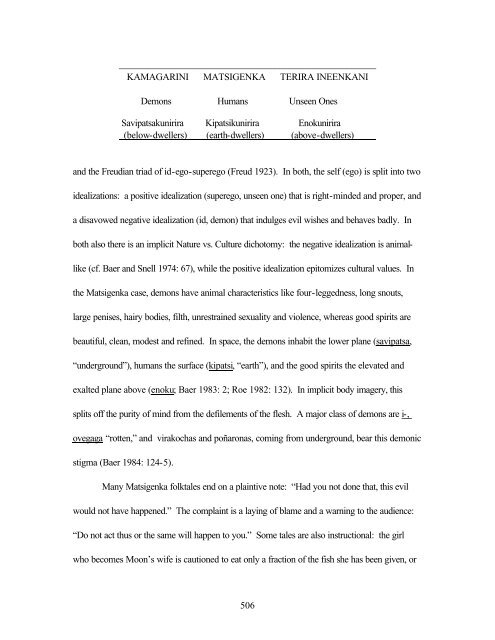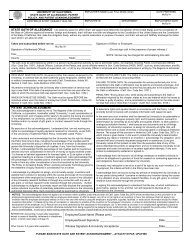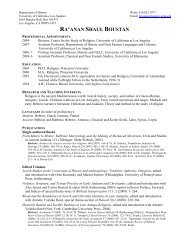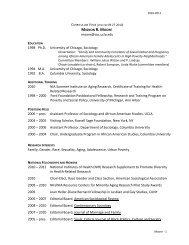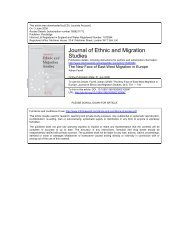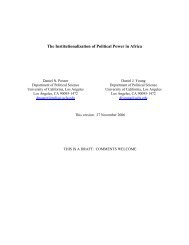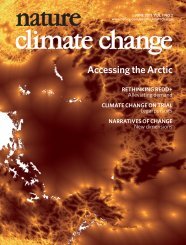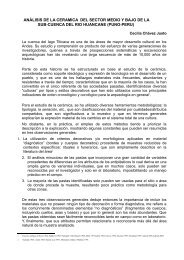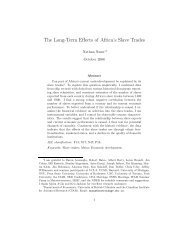433 Chapter Seven Cosmos For the Matsigenka of Shimaa, kameti ...
433 Chapter Seven Cosmos For the Matsigenka of Shimaa, kameti ...
433 Chapter Seven Cosmos For the Matsigenka of Shimaa, kameti ...
You also want an ePaper? Increase the reach of your titles
YUMPU automatically turns print PDFs into web optimized ePapers that Google loves.
_____________________________________________________<br />
KAMAGARINI MATSIGENKA TERIRA INEENKANI<br />
Demons Humans Unseen Ones<br />
Savipatsakunirira Kipatsikunirira Enokunirira<br />
(below-dwellers) (earth-dwellers) (above-dwellers)<br />
and <strong>the</strong> Freudian triad <strong>of</strong> id-ego-superego (Freud 1923). In both, <strong>the</strong> self (ego) is split into two<br />
idealizations: a positive idealization (superego, unseen one) that is right-minded and proper, and<br />
a disavowed negative idealization (id, demon) that indulges evil wishes and behaves badly. In<br />
both also <strong>the</strong>re is an implicit Nature vs. Culture dichotomy: <strong>the</strong> negative idealization is animallike<br />
(cf. Baer and Snell 1974: 67), while <strong>the</strong> positive idealization epitomizes cultural values. In<br />
<strong>the</strong> <strong>Matsigenka</strong> case, demons have animal characteristics like four-leggedness, long snouts,<br />
large penises, hairy bodies, filth, unrestrained sexuality and violence, whereas good spirits are<br />
beautiful, clean, modest and refined. In space, <strong>the</strong> demons inhabit <strong>the</strong> lower plane (savipatsa,<br />
“underground”), humans <strong>the</strong> surface (kipatsi, “earth”), and <strong>the</strong> good spirits <strong>the</strong> elevated and<br />
exalted plane above (enoku; Baer 1983: 2; Roe 1982: 132). In implicit body imagery, this<br />
splits <strong>of</strong>f <strong>the</strong> purity <strong>of</strong> mind from <strong>the</strong> defilements <strong>of</strong> <strong>the</strong> flesh. A major class <strong>of</strong> demons are i-,<br />
ovegaga “rotten,” and virakochas and poñaronas, coming from underground, bear this demonic<br />
stigma (Baer 1984: 124-5).<br />
Many <strong>Matsigenka</strong> folktales end on a plaintive note: “Had you not done that, this evil<br />
would not have happened.” The complaint is a laying <strong>of</strong> blame and a warning to <strong>the</strong> audience:<br />
“Do not act thus or <strong>the</strong> same will happen to you.” Some tales are also instructional: <strong>the</strong> girl<br />
who becomes Moon’s wife is cautioned to eat only a fraction <strong>of</strong> <strong>the</strong> fish she has been given, or<br />
506


